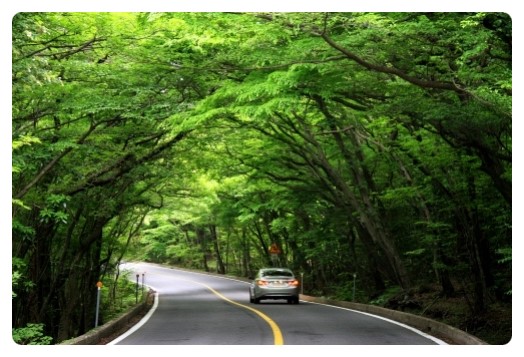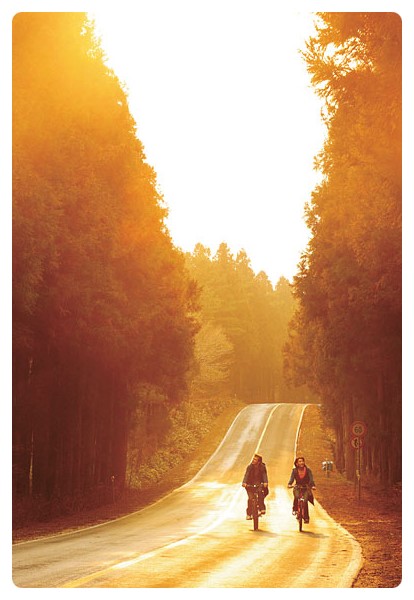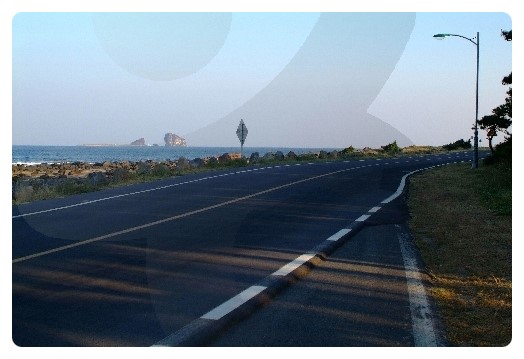Blogger
Jul 18, 2011
Jul 6, 2011
Outdoor Activities Amid Mungyeong's Stunning Scenery
A mountain range collectively called Baekdudaegan runs through the Korean Peninsula, connecting Mt. Baekdu and Mt. Kumgang in North Korea and Mt. Seorak and Mt. Jiri in the South. The scenic Mt. Juheul and Mt. Daeya in Mungyeong, North Gyeongsang Province, are an ideal destination for sports and leisure pursuits.
◆ Paragliding
Surrounded by mountains, Flyingland in Mungyeong is perched high in a basin on Mt. Dan, which forms rising air currents to facilitate easier gliding. Thanks to this natural terrain, it draws a number of professional paragliders from overseas.
◆ Paragliding
Surrounded by mountains, Flyingland in Mungyeong is perched high in a basin on Mt. Dan, which forms rising air currents to facilitate easier gliding. Thanks to this natural terrain, it draws a number of professional paragliders from overseas.

For beginners, there is an one-day paragliding program with an experienced trainer. "At first I was scared and thought it's dangerous, but having experienced it I know I won't ever forget it," said one tourist. "I felt dizzy as soon as my feet came off the ground. But as time went by I felt as if I was turning into a bird."

◆ Shooting
Some five km from the Jinnam Station in Mungyeong, a group of people with ear muffs shoot at orange clay pigeons at the signal of an instructor. Besides clay pigeon shootings, people over 14 can shoot airsoft guns and air pistols here. There is no need even for beginners to worry about safety as an instructor with more than five years' experience gives one-on-one tuition.
Some five km from the Jinnam Station in Mungyeong, a group of people with ear muffs shoot at orange clay pigeons at the signal of an instructor. Besides clay pigeon shootings, people over 14 can shoot airsoft guns and air pistols here. There is no need even for beginners to worry about safety as an instructor with more than five years' experience gives one-on-one tuition.

◆ Railroad Bikes
People ride bikes rather than a train on the railway at Jinnam Station in Mungyeong. When the mining industry prospered in the area some two decades ago, the railroad was used to transport coal, but now it has turned into a nostalgic tourism spot.
People ride bikes rather than a train on the railway at Jinnam Station in Mungyeong. When the mining industry prospered in the area some two decades ago, the railroad was used to transport coal, but now it has turned into a nostalgic tourism spot.

Next to the railroad runs the Yeong River from the east to west. Each section of the railbike course offers different scenery. A spokesperson with Mungyeong Tourism Promotion Corp. said, "We plan to extend the opening hours of the railbike course and stay open at night."

There are other various leisure and sports activities such as zip lining through the trees in the mountains, kart racing, ATV riding, and water sports.

Read more...
Ganghwa Observatory Offers Glimpses of N.Korea
The Ganghwa Peace Observatory is the only place on the popular tourist island that offers unobstructed views of the North Korean flatlands.
In the Civilian Control Zone just 1.8 km from North Korea, the observatory was a military lookout in the past. But amid improving inter-Korean relations in September 2008, it was turned into a tourist spot, and has been a popular destination for Korean and foreign visitors alike.
In the Civilian Control Zone just 1.8 km from North Korea, the observatory was a military lookout in the past. But amid improving inter-Korean relations in September 2008, it was turned into a tourist spot, and has been a popular destination for Korean and foreign visitors alike.
 The Ganghwa Peace Observatory
The Ganghwa Peace Observatory
A short drive from Seoul to Ganghwa Island leads to the entry control point. Visitors must show their ID card and get an entry permit to be attached to the car window. The observatory is a five-minute drive away.
On the first floor is an outdoor lookout point, from where a North Korean village can be seen.
Kang Chang-hak, a staffer at the Observatory said, "We can only see village nearby because of sea fog today, but on clear days there are views of Mt. Songak."
On the first floor is an outdoor lookout point, from where a North Korean village can be seen.
Kang Chang-hak, a staffer at the Observatory said, "We can only see village nearby because of sea fog today, but on clear days there are views of Mt. Songak."
 Outdoor and indoor lookout points of the observatory
Outdoor and indoor lookout points of the observatory
The third floor has powerful telescopes for more detailed views of North Korea both indoors and out. A video screen there also shows scenes of North Korea so that visitors on cloudy days can get a glimpse of it.
The striking thing is the number of cyclists, because Kaesong residents are rewarded with bicycles for farming the area on collective farms.
The striking thing is the number of cyclists, because Kaesong residents are rewarded with bicycles for farming the area on collective farms.
 The estuary where the river flows into the West Sea (top) and a North Korean village seen from the observatory
The estuary where the river flows into the West Sea (top) and a North Korean village seen from the observatory
An exhibition of pictures and videos on the Korean War can be seen on the second floor. A paper tree made of memos greets visitors at the entrance to the first floor. Visitors write messages hoping for reunification and hang them on the tree.
Outside is a shrine where people remember their families in the North.
Outside is a shrine where people remember their families in the North.

Next door, there is another must-see place nearby, the Ganghwa History Museum, which opened last year, bringing together relics scattered around the island. The miniature models show the past and present of Ganghwa Island.
 The Ganghwa History Museum
The Ganghwa History MuseumRead more...
Road Trip in Jeju
Jeju beach with emerald tints and peculiar living rocks are very beautiful like the fine paintings. You can have beautiful scenery by just pressing a button on your camera. In addition, driving the offshore will make you refresh your mind.
You will realize that time flies so fast when dropping by some attractive places while driving the offshore road. Now we will introduce you the must-go places in Jeju island.
Dive along the Green Forest!
The road which will be now introduced is 516 Forest Road Tunnel that was built for the first in this island. It is a shortcut from Jeju city on the South to Seogwipo city on the North of the island, crossing Mt. Halla. It definitely reduced the travelling time and is quite faster than the other ways. The road is rather zigzag, however, once you pass the Sungpan Rest Area, you will meet the trees that just look like a tunnel. While passing the tunnel we will feel as if the trees were greeting you.

<The lush greenness of the 516 Forest Road Tunnel > (Source : AsiaToday)
On your diving, you will see the Sancheon-dan altar for Mt. Halla and Sungpanak, the tracking course. Suak vallley is made of clear water from Baeknok-dam, the lake located on the top of the Mt. Halla. It ia connected by thick forest and azure sky.it's virgin forest and it's changed by the season. The road is lined up with Jeju typical trees and there are grazing ponies, too. 516 Forest Road Tunnel is thickly wooded and keeps the cool temperature even in summer. When you pass the tunnel, turn off the air-conditioner and open the car window to feel the beauty of nature.
Sagye Coastal Road
Sagye (four seasons) Coastal Road is an absolutely wonderful road which will surround you by the sea breeze and wind. As the Mt. Sanbang and Mt. Songak are located at each of the end of the seashore, the driving course is even peaceful and comfortable. Drivers can get the full view of the sea as well. Everyday many visitors are passing this beautiful coastal road to see the harmonized seashore, mountain and roads and all the beautiful sceneries around with its breath-taking sunset
<The road of the harmonized seashore, mountain and road> (Source: Korean Tourism Organization)
We can see not only the Sagye seashore not only the Brothers islands guarding the South Sea, and away from here, we can also see the Gapa island and southernmost island, Maraisland. Recently, the Sagye Coastal Road was designated as "One of the most beautiful 100 roads in Korea" by the Ministry of Construction and Transportation. After 50 minutes of driving along the No.95 local road from Jeju city, you will reach at a town which is the entrance of theSagye-ri harbor. Then, go toward the beach about 5 minutes, and you will be dazzled by the coolest sea in front of you.
This area is also famous for the Asian-first human’s footprints fossil of the Old Stone Age. There are other footprints of the elephants, dears and birds as well. Archeologists said this geographical strata was created in the fourth stages of the Cenozoic era 50,000 years ago. Since it was reported on the news, a number of tourists are continuously visiting here to see the fossils by themselves. However, since the Cultural Heritage Administration designated this area as one of the state-designated natural monuments, it has been impossible to enter the area.
Some people leave their car and take a walk around the area to see the Mt. Sanbang, Brothersislands, Gapa island , Mara island, and Mt. Songak. We hope you enjoy the road trip on SagyeCoastal Road.
Cedar Forest
Well, driving along the coast would be so good, but there is other driving course you would also be excited. It is the 27.3 km-long Rd. No.1112, which connects Gujwa-eup Pyongdae-ri and the Rd. No.516. The way ahead is full of cedar.

<Huge Cedars are lining up along the street> (Source: Munhwa Ilbo)
This road was awarded a grand prize by the Ministry of Construction and Transportation in 2002. It's very exotic as if you were in somewhere in north-American forests. Actually, this place appeared in many of CFs, movies and TV dramas. About 2,570 typical Jeju trees are growing wild here and make us feel refreshed when driving through or walking through the road.
Jeju driveways are full of blue water, beautiful estuary, cedars and secondary volcanoes. Why don't we leave for Jeju this Summer?
Read more...
Subscribe to:
Posts (Atom)
